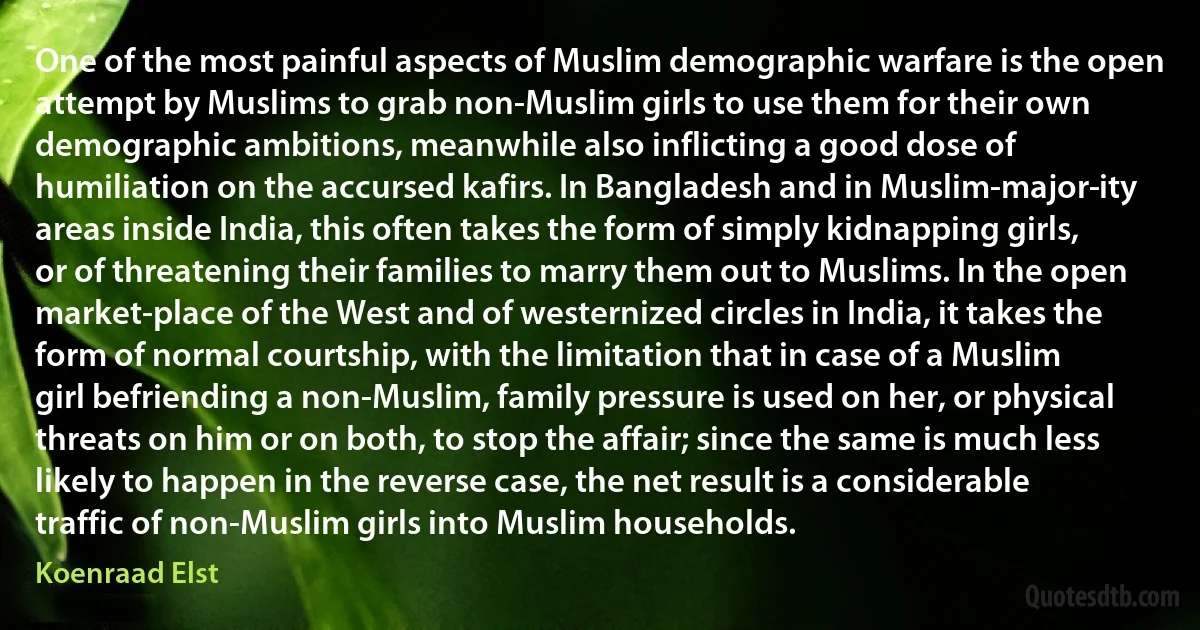
One of the most painful aspects of Muslim demographic warfare is the open attempt by Muslims to grab non-Muslim girls to use them for their own demographic ambitions, meanwhile also inflicting a good dose of humiliation on the accursed kafirs. In Bangladesh and in Muslim-majority areas inside India, this often takes the form of simply kidnapping girls, or of threatening their families to marry them out to Muslims. In the open market-place of the West and of westernized circles in India, it takes the form of normal courtship, with the limitation that in case of a Muslim girl befriending a non-Muslim, family pressure is used on her, or physical threats on him or on both, to stop the affair; since the same is much less likely to happen in the reverse case, the net result is a considerable traffic of non-Muslim girls into Muslim households.
Koenraad ElstRelated topics
attempt case family form girl good humiliation inside kidnapping less likely limitation meanwhile net open result stop traffic use warfare west bangladesh demographic girls non-muslimRelated quotes
Dreams can be classified in many different ways. We will examine four types. The first concerns dreams that occur as a result of physiological stimulation. [...] The second category involves thoughts that are dormant in the subconscious. Whatever you think about often becomes impressed in your subconscious mind. [...] The third type of dream concerns the predominating thoughts you have when you are awake. [...] The fourth category of dreams involves those that help to work out karma, that is, lessons that are to be experienced in this lifetime. Sometimes, dreams can be used as a medium to play out the karma that one has accumulated. [...] This serves two functions: one, it saves time because the dynamics do not have to be played out in the physical realm and two, the lessons learned through the subtle body penetrate the soul more thoroughly, leaving lasting impressions.

Bhakti Tirtha Swami
Throughout our history we have been challenged to armed conflict by nations which sought to destroy our independence or threatened our freedom. The young men of America have risen to those occasions, giving themselves freely to the rigors and hardships of warfare. But the stamina and strength which the defense of liberty requires are not the product of a few weeks' basic training or a month's conditioning. These only come from bodies which have been conditioned by a lifetime of participation in sports and interest in physical activity. Our struggles against aggressors throughout our history have been won on the playgrounds and corner lots and fields of America. Thus, in a very real and immediate sense, our growing softness, our increasing lack of physical fitness, is a menace to our security.

John F. Kennedy
Everybody knows that the great reversed triangle of land, with its base in the north and its apex in the south, which is called India, embraces fourteen hundred thousand square miles, upon which is spread unequally a population of one hundred and eighty millions of souls. The British Crown exercises a real and despotic dominion over the larger portion of this vast country, and has a governor-general stationed at Calcutta, governors at Madras, Bombay, and in Bengal, and a lieutenant-governor at Agra.But British India, properly so called, only embraces seven hundred thousand square miles, and a population of from one hundred to one hundred and ten millions of inhabitants. A considerable portion of India is still free from British authority; and there are certain ferocious rajahs in the interior who are absolutely independent.

Jules Verne
Islamic literary sources provide far more extensive evidence of temple destruction by the Muslim invaders of India in medieval times. They also cover a larger area, from Sinkiang and Transoxiana in the North to Tamil Nadu in the South, and from the Seistan province of present-day Iran in the West to Assam in the East. As we wade through this evidence, we can visualise how this vast area, which was for long the cradle of Hindu culture, came to be literally littered with the ruins of temples and monasteries belonging to all schools of Sanãtana Dharma-Bauddha, Jaina, Šaiva, Šãkta, VaishNava and the rest. Archaeological explorations and excavations in modern times have proved unmistakably that most of the mosques, mazãrs, ziãrats and dargãhs which were built in this area in medieval times, stood on the sites of and were made from the materials of deliberately demolished Hindu monuments.

Sita Ram Goel
For the Muslim, religion traditionally was not only universal but also central in the sense that it constituted the essential basis and focus of identity and loyalty. It was religion which distinguished those who belonged to the group and marked them off from those outside the group. A Muslim Iraqi would feel far closer bonds with a non-Iraqi Muslim than with a non-Muslim Iraqi. Muslims of different countries, speaking different languages, share the same memories of a common and sacred past, the same awareness of corporate identity, the same sense of a common predicament and destiny. It is not nation or country which, as in the West, forms the historic basis of identity, but the religio-political community, and the imported Western idea of ethnic and territorial nationhood remains, like secularism, alien and incompletely assimilated.

Bernard Lewis
